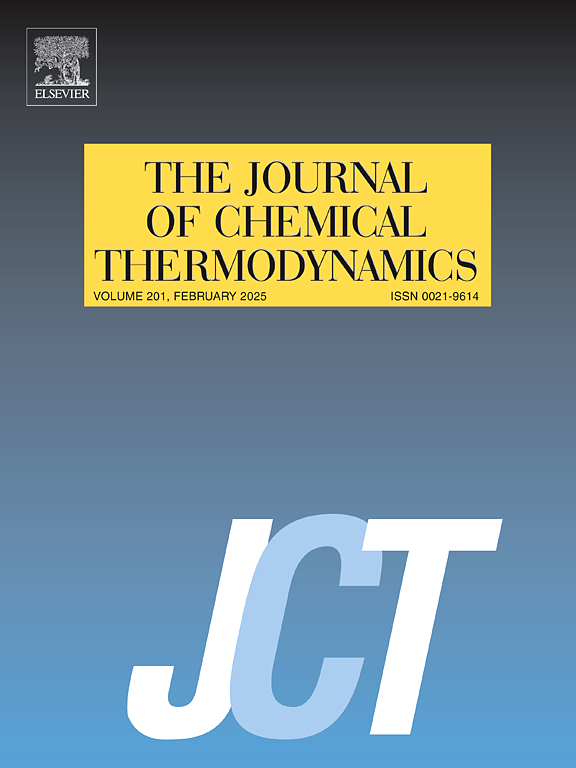Study of thermodynamic and acoustic properties of DEGMME/ DEGMEE in aqueous erythritol solutions at different temperatures
IF 2.2
3区 工程技术
Q3 CHEMISTRY, PHYSICAL
引用次数: 0
Abstract
Artificial sweeteners also known as non-caloric sweeteners, have surged in popularity owing to their sweet taste and lack of metabolic impact. Sugar alcohols have applications in various food products, thereby holding a significant position in both the food and pharmaceutical sectors. Erythritol is a type of sugar alcohol, it plays a significant role in the present study as a key component of a ternary mixture. Other important components of this study are DEGMME (diethylene glycol monomethyl ether) and DEGMEE (diethylene glycol monoethyl ether). These are basically glycol ethers that are used in many industries for different purposes. Using values of density, and speed of sound, , for a ternary mixture at various concentrations (0.10, 0.20, and 0.30) , this study calculates volumetric and acoustic properties at different four temperatures (288.15––318.15 K). Additionally, other useful parameters such as limiting apparent molar expansibilities () and its first-order derivatives were also calculated. Unlike previous research, which primarily focused on binary mixtures, this study delves into a more complex system, and providing valuable insights into solvation behaviour and molecular interactions. These results, derived from precise measurements using a Density and Sound Analyzer (DSA), that provide a comprehensive understanding of the interaction behaviour and structural changes within the studied systems.
不同温度下赤藓糖醇水溶液中 DEGMME/ DEGMEE 的热力学和声学特性研究
人造甜味剂也被称为无热量甜味剂,由于其甜味和缺乏代谢影响而受到广泛欢迎。糖醇在各种食品中都有应用,因此在食品和制药部门都占有重要地位。赤藓糖醇是糖醇的一种,作为三元混合物的关键组分,在本研究中发挥了重要作用。本研究的其他重要组成部分是DEGMME(二乙二醇单乙醚)和DEGMEE(二乙二醇单乙醚)。这些基本上是乙二醇醚,在许多工业中用于不同的目的。利用不同浓度(0.10、0.20和0.30)mol∙kg-1的三元混合物的密度、ρ和声速c值,本研究计算了不同四种温度(288.15—318.15 K)下的体积和声学特性。此外,还计算了其他有用的参数,如极限表观摩尔膨胀率(Eϕ0)及其一阶导数∂Eϕ0/∂Tp。不像以前的研究,主要集中在二元混合物,这项研究深入到一个更复杂的系统,并提供宝贵的见解,溶剂化行为和分子相互作用。这些结果来自密度和声音分析仪(DSA)的精确测量,提供了对所研究系统内相互作用行为和结构变化的全面了解。
本文章由计算机程序翻译,如有差异,请以英文原文为准。
求助全文
约1分钟内获得全文
求助全文
来源期刊

Journal of Chemical Thermodynamics
工程技术-热力学
CiteScore
5.60
自引率
15.40%
发文量
199
审稿时长
79 days
期刊介绍:
The Journal of Chemical Thermodynamics exists primarily for dissemination of significant new knowledge in experimental equilibrium thermodynamics and transport properties of chemical systems. The defining attributes of The Journal are the quality and relevance of the papers published.
The Journal publishes work relating to gases, liquids, solids, polymers, mixtures, solutions and interfaces. Studies on systems with variability, such as biological or bio-based materials, gas hydrates, among others, will also be considered provided these are well characterized and reproducible where possible. Experimental methods should be described in sufficient detail to allow critical assessment of the accuracy claimed.
Authors are encouraged to provide physical or chemical interpretations of the results. Articles can contain modelling sections providing representations of data or molecular insights into the properties or transformations studied. Theoretical papers on chemical thermodynamics using molecular theory or modelling are also considered.
The Journal welcomes review articles in the field of chemical thermodynamics but prospective authors should first consult one of the Editors concerning the suitability of the proposed review.
Contributions of a routine nature or reporting on uncharacterised materials are not accepted.
 求助内容:
求助内容: 应助结果提醒方式:
应助结果提醒方式:


